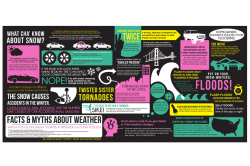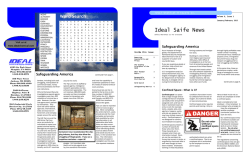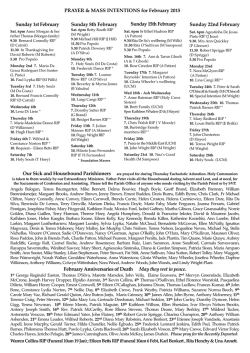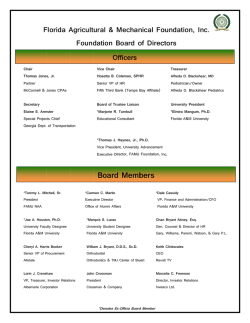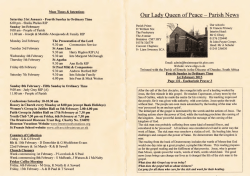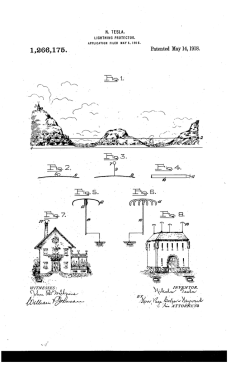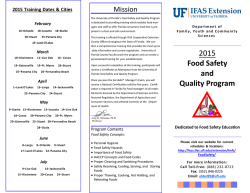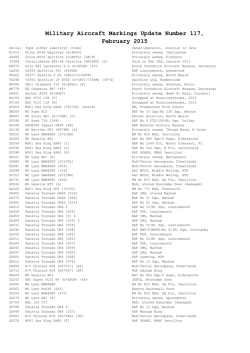
Severe Weather Awareness Week Activity Book
Professor Tinkermeister’s Severe Weather Awareness Activity Book Hey Kids! It’s Professor Tinkermeister! Follow me through this guide to learn how to stay safe and prepare for the severe weather we have here in Florida! Table of Contents Lightning & Thunderstorms Rip Currents Tornadoes Hurricanes Flooding Extreme Temperatures Wildfires Disaster Supply Kit Page 4 Page 5 Page 7 Page 9 Page 11 Page 14 Page 16 Page 17 How many times can you spot Professor Tinkermeister and his weather-watching wonder in this activity book? PAGE 1 Follow me! Message from Florida Governor Rick Scott In Florida, we are on a mission to make our state the world’s top destination where families can get a job and live their dreams. As Floridians, we enjoy pleasant weather year-round, and every day more people are moving to our state to enjoy our great climate and business opportunities. In fact, Florida recently surpassed New York as the third largest state in the nation. However, we always need to remember the potential for severe weather. I encourage you and your family to Get A Plan that prepares you for all types of disasters and to share your plan with your family and your friends. Making sure your family and business is prepared for severe weather is essential to being able to pull through a storm safely. Hurricanes are perhaps the most distinctive severe weather threat we face. But the size and diversity of our wonderful state mean we all must be prepared for a number of possibilities, including wildfires, rip currents, severe thunderstorms, and lightning. This Severe Weather Awareness Guide contains valuable information on how you and your family can remain safe in an emergency. I encourage you to take steps now to prepare yourself, your family, your pets, and your business. PAGE 2 Message from Florida Division of Emergency Management Director Bryan W. Koon The Florida Division of Emergency Management’s mission is to prepare for disasters, to respond to emergencies, and to mitigate against the impact of future events. Floridians remember the historic hurricane seasons of 2004 and 2005 culminating with Hurricane Wilma, which made landfall on October 24, 2005. While the last ten years have not seen a hurricane make landfall in Florida, the state has experienced a number of other disasters such as tornadoes, severe storms, wildfires and flooding, some of these record breaking. Residents and visitors are reminded that severe weather can occur at any time and being prepared is the key to building resilient communities. This Severe Weather Awareness Guide includes information on a number of hazards and information on how to prepare your family. Take a few minutes to discuss the information in the guide. Discuss your family emergency plan and identify a location for your family to evacuate if needed. Build a disaster supply kit by visit www.FLGetAPlan.com. The easy step-by-step tool will guide you through the process. By taking the steps to prepare today, you can know your family is ready for any event. PAGE 3 Lightning & Thunderstorms Did you know that Florida has the most lightning strikes in the whole United States? This is why it is important to know how to stay safe when there is lightning. The 30/30 Rule When thunder roars, first go indoors. Then use the 30-30 Rule to determine the threat of lightning in your area. Lightning & Thunderstorm Facts Lightning is a bright flash of electricity produced by a thunderstorm. All thunderstorms produce lightning and are dangerous. If you can hear thunder, you are in danger. Lightning can strike the same place twice. Lightning & Thunderstorm Safety Tips If you hear thunder, go indoors. Stay inside for at least thirty minutes after the thunder stops. If you are outside in a storm, stay away from trees. 30 Seconds: Count the seconds between seeing lightning and hearing thunder. If this time is less than 30 seconds, lightning is still a potential threat. Seek shelter immediately. 30 Minutes: After hearing the last thunder, wait 30 minutes before leaving shelter. Many lightning deaths occur after the storm passes. Stay in a safe area until you are sure the threat has passed. PAGE 4 Rip Currents What Are Rip Currents? A rip current is a strong surface current flowing outwards from a shore. Rip Current Facts: Rip currents are dangerous. Rip currents can be very narrow or more than 50 yards wide. Rip currents do not pull people under the water, they pull people away from shore. Rip Current Safety Tips: Know how to swim. Never swim alone, and swim near a lifeguard whenever possible. If caught in a rip current, stay calm, yell for help, and swim sideways. If you cannot swim out of the rip current flip over and float. PAGE 5 Rip Current Cross Word Puzzle Across 3. A strong surface current flowing outwards from a shore 5. Expert swimmer that protects and rescues people at a pool or the beach 6. Place where you go to soak up sun and build sand castles Down 1. Long body of water that curls into an arch and breaks on the shore 2. Sleeveless inflatable jacket used to keep a person afloat in water 4. If you cannot swim and are stuck in a rip current you should flip on your back and do this Can you help me solve this puzzle? PAGE 6 Tornadoes What is a tornado? A tornado is a violent rotating column of air extending from a thunderstorm to the ground. Tornado Facts Tornadoes can happen at any time of the year. A Tornado Watch means tornadoes are possible in your area. Stay tuned to the radio or television news. A Tornado Warning means a tornado either is on the ground or has been detected by Doppler radar. Seek shelter immediately. Tornado Safety Tips Have a family emergency plan that includes where to go in the event a tornado threatens your home. During a tornado, go to an interior room without windows on the lowest floor of the building. Do not stay in an automobile. Go to a secure building. PAGE 7 Tornadoes Word Scramble Help me unscramble the words! 1. ATRONOD _______________________________ Hint: A violent rotating column of air extending from a thunderstorm to the ground. 4. FUNELN LDOCU _______________________________ Hint: A rotating cone-shaped column of air extending downward from the base of a thunderstorm, but not touching the ground. 2. WUPSEAORTT _______________________________ Hint: A weak tornado that forms over water. 5. HNIGILNGT _______________________________ Hint: A bright flash of electricity produced by a thunderstorm. 3. UHMORESTTRND _______________________________ Hint: A storm with thunder and lightning. 6. LRPPDEO DRRAA _______________________________ Hint: Detects precipitation intensity, wind direction and speed, and provides estimates of hail size and rainfall amounts. PAGE 8 Hurricanes What is a hurricane? A type of storm called a tropical cyclone, which forms over tropical or subtropical waters. Hurricane Facts Hurricanes only form over really warm ocean water of 80°F or warmer. Storm surges are frequently the most devastating element of a hurricane. The Atlantic hurricane season is from June 1 to November 30. Hurricane Safety Tips Before a hurricane, have a family emergency plan, build a disaster supply kit and know where to go if you and your family need to evacuate your home. During a hurricane, stay indoors. If you live in a mobile home, leave and go to a shelter. If emergency managers say to evacuate, do so immediately. After a hurricane, stay indoors until it is safe to come out. Watch out for flooded roadways and do not drink tap water until officials say it is safe to do so. PAGE 9 Hurricane Safety Message Decoder PAGE 10 Flooding What is a flood? Depending on the type, floods can develop very slowly over time after extensive rainfall or in just a few minutes, very quickly without warning. Flood Facts Flooding can happen any time of the year. Flooding can hurt people, animals and buildings. Flooding is extremely dangerous. Flood Safety Tips Have a family emergency plan that includes an evacuation plan for your family. When walking do not cross a flooded roadway or a flowing stream. If a flood occurs, move to higher ground immediately. Adults should not drive into a flooded roadway. Remember, “Turn Around, Don’t Drown!” PAGE 11 Coloring Activity Rabbit travels from Florida to Alaska to meet his cousin the Snowshoe Hare and her friends Moose and Muskox. Color in the picture of Muskox, Rabbit, Snowshoe Hare and Moose as they capture the moment with a “selfie”! PAGE 12 Color Muskox, Snowshoe Hare, Rabbit & Moose! PAGE 13 Moose is caught in a flash flood! Can you help us hand him a lifesaver and get him to safety? Flood Maze Start PAGE 14 Extreme Temperatures Hot Weather Safety Wear a hat, sun glasses and loose, dry clothing. Wear sunscreen, even on cloudy days. Stay out of the sun between 10 a.m. and 4 p.m. as the sun rays are the strongest then. Drink lots of water, even if you are not thirsty. If you feel dizzy, weak or if your head or stomach hurts let an adult know. Cold Weather Safety Dress in layers and wear a hat and gloves. Stay out of the wind and stay dry. Bring your outdoor pets inside or give them a warm place to stay. Home fires are very common during the winter season. Make sure you know at least two ways out of each room at home and have a meeting place in your neighborhood in case you need to leave your home in the event of an emergency. Wheww...its hot here... PAGE 15 Wildfires What is a wildfire? A wildfire is an uncontrolled fire often occurring in wildland areas. Wildfire Safety Tips Have a Family Emergency Plan that includes an evacuation plan for your family. Work with adults to mitigate your home including removal of pine needles and dry leaves within 5 feet of your home. Report a fire to an adult immediately. ARSON EXTINGUISHER FOREST SMOKE WILDFIRE BURNING FAMILY PLAN MATCHES SPARK EVACUATE FLAMES RANGERSES PAGE 16 What do you need in a Disaster Supply Kit? Join the kids from the book “The Oak Tree Club” as they work together to build their family emergency plan and a disaster supply kit in preparation for a hurricane threatening their community. Follow their lead and start making a plan with your family! ___ Water (at least 1 gallon daily, per person, for minimum of 3 days) ___ First Aid Kit ___ Flashlight with extra batteries ___ Food (enough for each family member for minimum of 3 days) ___ At least one week supply of prescriptions ___ All Hazards Weather Radio ___ Battery-Powered Radio ___ Copy of important papers ___ Non-electric can opener PAGE 17 Get a Plan! For more information visit: Check out Professor Tinkermeister’s website www.kidsgetaplan.com or our Kids Get a Plan mobile apps for more games, downloadable books, and other fun activities! PAGE 18 Special Thanks to our Partners!
© Copyright 2024
